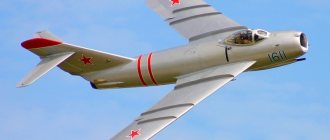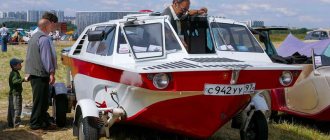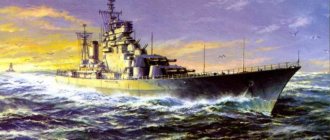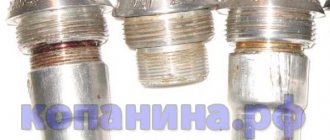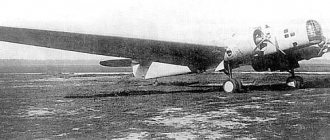During the Great Patriotic War, as part of the Lend-Lease program, a number of Ford GPA vehicles arrived in the Soviet Union. These vehicles are adapted to independently overcome water obstacles. In the post-war years, the USSR began to actively copy foreign cars, which were in demand by army and civilian customers.
GPA vehicles were able to receive a positive assessment from the army command, so they were included in the promising type of automotive equipment planned for release. The first Soviet copy was GAZ-011, and the already modified car, produced in a fairly large series, received the index GAZ-46.
The history of the creation of a floating car
The military was so interested in such types of equipment that already in 1948, the Scientific Automotive Institute (NAMI), on behalf of the Council of Ministers and the Ministry of Automobile and Tractor Industry, began developing an amphibian based on the mastered platform of the GAZ-67 SUV. The terms of reference spoke about equipment designed to transport by land and water a crew and sabotage groups of six people or 500 kg of cargo, and tow light trailers, pontoons and other watercraft used by engineering troops on water.
The first models were called NAMI-011, passed interdepartmental tests and were recommended for adoption by the troops, despite the fact that the design was crude.
The production of the amphibian was entrusted to the Gorky residents. The plant's specialists made many changes to the design, improving the characteristics of the vehicle as far as the mechanics of the GAZ-67 allowed.
From 1951 to 1953, pilot batches began to arrive to the troops under the name GAZ-011 and satisfied the military so much that serious difficulties arose in the development and implementation of the improved GAZ-46 vehicle, in which comments on the previous model were taken into account and most of its shortcomings were eliminated.
Serious intrigues wove, heads rolled, management changed, but in the end, a new car based on the more modern GAZ-69 saw the light of day.
Unfortunately, the amphibian was not produced for long, until the end of the fifties, because in the first post-war decades not only technology, but also combat tactics changed, and light amphibious vehicles were no longer needed. In addition, production of the basic GAZ-69 was transferred to the Ulyanovsk Automobile Plant, where amphibians could not be produced for purely production reasons.
Lend-Lease technique
The American amphibian DUKW-353 could move through water at speeds of up to 10 km/h. | Photo: soviethammer.blogspot.com.
In the USSR, amphibious vehicles first appeared en masse during the Great Patriotic War, and their first drivers were soldiers of the Red Army. Our troops received several thousand small Ford GPAs, as well as more than five hundred heavy three-axle DUKW-353s. American Lend-Lease equipment was used for its intended purpose on the way to Berlin. Both models performed well when crossing rivers and lakes.
Description of design
The buoyancy of the MAV was ensured by a steel welded body on a frame made of box profiles. It was a pontoon type building with no doors. The inside of the floating car was divided by vertical transverse partitions into 3 compartments: bow, middle and stern. In the bow compartment of the car there was an engine-transmission compartment (MTO).
The middle compartment was the cabin for the crew and passengers, and in the rear there was a luggage compartment. On the bow of the floating car there was a reversible wave barrier, which was raised by the crew before the car entered the water.
The shield or screen prevented the car from “burying its nose” in the water, and also protected the air intake, necessary for cooling the engine, and the central compartment from water ingress. Between the headlights there was a bollard, necessary for mooring the amphibian on the water, and a capstan for the rescue buoy.
Lever shock absorbers were installed outside the GAZ-46 body, and spare wheels were placed on the rear upper platform.
The GAZ-46 floating car was equipped with a 4-cylinder engine from the GAZ-M20 Pobeda passenger car, and the wheel suspension and transmission were borrowed from the GAZ-69 SUV.
The car's engine was connected to a manual gearbox, which had three forward and one reverse gears, and a two-speed transfer case. On the water surface, the car could move with the help of a three-bladed propeller, which was driven by a driveshaft from the transfer case.
The direction of movement of the car in the water could be changed by a water rudder, which was placed in a stream of water thrown by the boat's propeller. A distinctive feature of the GAZ-46 (MAV) amphibian was the wheels of a special design; to increase cross-country ability, they made it possible to drive on flat tires without any risk of them turning and water getting inside the tire.
Since the car was floating, all its electrical wiring was made with sealed electrical connectors; the ignition distributor, which was completely sealed, did not need additional protection.
A muffler and exhaust pipe were installed on the bow deck of the floating GAZ-46 car. True, the muffler created so much noise that it unmasked the car.
On the other side of the bow deck there was a gas tank neck, that is, if the need arose, it was possible to refuel the fuel tank directly on the water.
The design of the cockpit, if it is appropriate to use such a loud definition here, was spartanly simple, since the floating car was originally designed on the instructions of the military. There was simply no special level of comfort provided for either the crew or passengers. And in terms of its general design, the floating GAZ-46 car rather looked like a boat.
The MAV instrument panel was completely borrowed from the GAZ-69 SUV. At the same time, there was a tachometer and a warning light on the instrument panel, which notified about the appearance of water in the hold. The transmission control levers were on the right side of the driver.
The pedal brackets were distinguished by their unusual shape and were located close to each other in order to have as few different technological holes as possible through which water could get inside the car body. The windshield frame could be laid on the hood, and a canvas awning could easily be stretched over the passenger compartment.
The front row of seats included two chairs: for the commander and the driver. Behind them was mounted a three-seater bench that had no adjustments. For ease of maintenance, a fuel filter was installed in the vehicle's cabin.
The amphibious vehicle GAZ-46 (MAV) entered service with individual transport and landing battalions, as well as individual pontoon-bridge regiments; in addition, it was exported to countries that were parties to the Warsaw Pact. Production of the car continued in the Soviet Union from 1953 to 1958, when production of the basic GAZ-69 was transferred to the UAZ plant.
At the same time, in Ulyanovsk there was simply no production capacity to continue the production of a floating car, which, along with the small need for such machines, was the reason for the cessation of their production. In addition, the first BRDMs had already begun to arrive in the army. There is no exact information on the number of MAVs produced, but, apparently, about 650 of these vehicles were assembled in total.
Amphibian transmission
The car was equipped with a three-speed manual transmission with gear ratios in three gears of 3.115, 1.772 and 1.0, respectively, and in the rear - 3.738. The transfer case is two-stage, with gear ratios of 1.15 and 2.78. The gear ratio on the bevel main gear with a spiral tooth is 5.125, on the steering mechanism, which is a globoidal worm with a double roller, 18.2.
The clutch is a dry single-plate clutch. Shoe brakes, service - on all four wheels with hydraulic drive from the pedal, parking - on a transmission with manual mechanical drive.
Application and technical parameters
All built GAZ-46 amphibians were initially transferred to the Soviet Army, where they served on the staff of pontoon-bridge regiments and separate airborne battalions responsible for establishing crossings.
Some of the vehicles were transferred to the armies of the Warsaw Pact countries.
As GAZ-46 vehicles were written off, they were sent to storage bases, from where many of them ended up with private owners. Early production amphibians built on the GAZ-67B chassis are of particular value.
There are no direct analogues to the GAZ-46 amphibian; it makes sense to compare the characteristics with the amphibious vehicles of the USA and Germany that were used during the war. The American GPA, which served as a prototype for the Soviet development, has very similar parameters. The machine has a shorter body length while simultaneously increasing its width; the speed data is almost the same.
| GAZ-46 | Ford GPA | Volkswagen Type 166 | |
| Length, mm | 4930 | 4620 | 3825 |
| Width, mm | 1900 | 2130 | 1480 |
| Height, mm | 1770 | 1750 | 1615 |
| Weight, kg | 1270 | 1595 | 910 |
| Engine power, hp | 55 | 60 | 25 |
| Travel speed on land/water, km/h | 90/9 | 89/8,6 | 80/10 |
| Load capacity, kg | 500 | 500 | 435 |
The German car Typ 166, built on the components of the legendary Kaefer, was equipped with a boxer engine with a forced air cooling system.
Despite the noticeably lower power, the German amphibian has similar speed characteristics, achieved by reducing weight and dimensions. Moreover, the Typ 166 body is designed for only 4 people, while Soviet and American cars can accommodate 5 passengers each.
The GAZ-46 amphibian is not produced by any manufacturer of scale replica models.
The only production version of the miniature car was a 1:43 scale model, released in China and distributed in the magazine series “Autolegends of the USSR.” In the late 90s, the private workshop “Ural Falcon” produced a small batch of resin model of the car. The amphibian can also be seen in several films, for example, the GAZ-46 can be seen in the film “Five Brave”, filmed in 1970.
Amphibious models
GAZ-46 was honored as number 100 to be included in the collection of models of the Russian scientific and educational magazine about Soviet cars “Autolegends of the USSR”. The publication, dedicated to one model, was published twice a month, and included a collector's replica car made in China at 1:43 scale by the Italian company DeAgostini. The declared circulation was 120 thousand copies. The dark green car is quite detailed in detail for such a scale, but experts say that the wheels in the model are not original, and the awning spoils the appearance. The model is disassembled into four parts: the body, the interior, the bottom and that same unsightly awning.
A model of the amphibian is being made in the same scale by the Ural Falcon workshop in Yekaterinburg, not only in green, but also in more decorative colors, for example, blue or red.
The GAZ-46 car was mass-produced until the end of 1958 and had no modifications; it remained in service for more than thirty years, although BRDMs were already used as reconnaissance vehicles. Amphibians were in service with pontoon-bridge regiments and airborne transport battalions not only in the Soviet Union, but also in the Warsaw Pact countries. It is not known how many cars are on the move today, but they exist, regularly transport caring owners on fishing or hunting trips and serve as a source of their rightful pride, and participate in displays of special equipment.
Design features of the GAZ-46
The design of the GAZ-46 car is incredibly simple and ascetic, however, it does not look like anything special compared to other post-war cars. If we take into account that this amphibian was conceived specifically for military needs, the Spartan situation even now is not very shocking. The appearance of the amphibian makes one think of boats, and does not at all resemble SUVs. Despite this, on off-road the vehicle will not lag behind armored personnel carriers and infantry fighting vehicles.
The dashboard of the car, which cannot even be called the now fashionable word “dashboard,” was completely borrowed from the GAZ-69. In addition, it received several additional functions. This is a light bulb that gave a signal if water got into the hold, and a tachometer. One of the features of this machine is that the pedals are located very close to each other. This was done in order to reduce the number of technological holes in the amphibian body.
The windshield could be placed on the hood of the car along with its frame. The fuel filter was installed directly in the cabin. This simplified fuel system maintenance. To avoid carburetor clogging, it was recommended to monitor the condition of the fuel filter, changing it as it becomes clogged.
The MAV amphibian entered service with the airborne and engineering forces of the USSR. The scouts also had such vehicles. The cars were produced from 1953 to 1958, but during this time about 650 units were assembled, since the need for them was minimal. With the advent of the first BRDM-1, which were more universal, the need for specific amphibians disappeared.
Currently, such machines can only be seen among collectors, lovers of unusual military equipment and in museums.
Prerequisites for the occurrence
The experience of World War II showed the strengths and weaknesses of Soviet military equipment, as well as gaps in its creation. There were no floating cars in the army.
All-wheel drive four-wheeled Ford GPA amphibians and six-wheeled DUKW trucks received under Lend-Lease made it easier to cross rivers in Eastern Europe during the Soviet offensive against Nazi Germany.
Naturally, this technology was taken into account, and immediately after the war, both passenger and cargo amphibious vehicles were included in the long-term rearmament plan, along with other types.
First of all, the military was interested in a light command vehicle capable of crossing water obstacles and moving in the same group with armored vehicles.
The DUKW cargo truck became the first prototype of the ZIS-485, a large waterfowl vehicle (BAV). Over time, the GAZ-46 MAV, a small aquatic vehicle, became an analogue of the floating SUV Ford GPA.
GAZ-011 or GAZ-46
Despite all the shortcomings of NAMI-011, the designers of the Gorky Automobile Plant managed to cope with the problems and make a truly high-quality car. GAZ-011 was superior to the original NAMI development in the following parameters:
- The weight of the car has been significantly reduced;
- Speed has increased both on land and on water;
- The reliability of the machine has increased;
- The assembly process has been simplified.
The military command really liked the new GAZ-011 during testing, which created additional problems for the Gorky Automobile Plant. They planned to replace the GAZ-67 with a new model, but the production of the amphibian prevented this from happening.
It is unknown how long this paradoxical situation would have lasted if in 1952 designer Kreshchuk had not sent a secret letter to Stalin, where he told what was going on at the plant. Measures were taken immediately:
- Many officials and designers were demoted;
- The award for the development of NAMI-011 was promptly cancelled;
- The management of the Gorky Automobile Plant was strongly recommended to do it in a way that is beneficial for the state.
Based on this, it was decided to produce the GAZ-46, although in 1953 68 GAZ-011 amphibians were produced and sent to the army.
Amphibian abroad
There are lovers of floating cars all over the world. A striking example is the event in Treben-Trarbach (Germany) in August 2014, when amphibious vehicle owners gathered on the Moselle River in their vehicles. There were demonstrations both on the roads and down the river.
This celebration of the triumph of technical thought lasted for a week. About sixty different vehicles took part in it, including unique homemade amphibians.
Interestingly, most of them were the same floating Ford GPA SUVs (there were fourteen of them), which served as the prototype for the GAZ-46. The photo confirms this relationship even today. In the top photo is a Ford, and below is a Russian floating SUV (there were five of them at the meeting).
By the way, there were the same number of DUKW and Porsche Schwimmwagens trucks that participated in the Second World War in the Wehrmacht army.
LuAZ-967
By order of the Airborne Forces, a light waterfowl transporter was created, called TPK - Front Edge Transporter. It was intended to evacuate the wounded from the battlefield.
The air-cooled engine capacity was 887 cubic centimeters and the power was 30 horsepower. A little later, it was replaced by the LuAZ-967A model with a more powerful MeMZ-967A power unit.
Left bank, right bank...
The most famous (and most widely used) cars are those used as part of pontoon parks.
While horse traction was used to transport elements of the crossings, the mass of these elements (and, accordingly, the carrying capacity of the crossings themselves) had to be limited, and the pontoons were a completely autonomous structure, that is, a structure independent of the carrier. The appearance of tanks weighing 32 tons and artillery systems with an axle load of 9 tons required the creation of a pontoon fleet with a significantly higher carrying capacity. At the same time, it was inappropriate to use heavy pontoon parks for establishing easy crossings. Thus, it was necessary to create two types of pontoon parks - light and heavy. This problem was solved by the Military Engineering Academy and the Military Engineering Training Ground, which developed and put into service with the Red Army the heavy pontoon park N2P and the light pontoon park - NLP. N2P was intended for building bridges on floating supports with a carrying capacity from 16 to 60 tons or organizing ferry crossings with a carrying capacity from 16 to 60 tons. In addition, the N2P fleet made it possible to build bridges on rigid supports 45 m long under a load of 16 tons or 26 m long under a load of 24 T.
The design of such a park did not allow mechanically crushing its total mass, increasing the length of the convoy. The park set included 16 bow half-pontoons, 32 middle half-pontoons, a set of spans, 16 entrance ramps, gantry supports, 16 outboard units SZ-20 (or 10 towing motor boats BMK-70, or 16 motor-oars MV-72), as well as auxiliary equipment.
On January 1, 1941, the engineering troops of the Red Army had up to 265 ferry parks of all types (N2P, NLP, MDPA-3), including 45 heavy ones (N2P), more than 1060 mobile power plants, over 680 sawmill frames and machines and many other means , including those directly related to automotive technology.
Subsequently, existing crossing facilities were modernized and new ones were created: at the Navashinsky Machine-Building Plant, a modernized version of the heavy pontoon park N2P received the designation N2P-41, and a heavy pontoon-bridge park TMP, designed for 70 tons, appeared. The latter was transported by 102 vehicles, of which 72 were pontoon vehicles, including specially equipped ZIS-5.
AutomotiveWaterfowl good morning with competition)
Good morning, suns! Have the most wonderful mood for the whole day!
On August 27, Russia celebrates Russian Cinema Day. Happy holiday!
Question for today:
Do you go to cinemas to watch Russian films?
And now the news)
In Honduras, a pregnant girl woke up in a coffin a day after the funeral
In Honduras, a pregnant girl woke up in a coffin a day after the funeral. 16-year-old Nacy Perez died from lack of oxygen while they were trying to extract her, The Telegraph reports. The girl lost consciousness near her home. After being taken to the hospital, doctors pronounced him dead.
Perez was buried in her wedding dress because she had recently gotten married. When her husband came to the cemetery the next day, he heard muffled screams and knocking. The fact that the girl was buried alive is proven by the wounds on her hands that she received while trying to get out.
Doctors believe Perez initially suffered a panic attack, which led to temporary cardiac arrest.
Six flasks of Japanese whiskey delivered to the ISS
The Japanese space cargo ship Konotori, which successfully docked with the ISS on Monday, carried water, food and scientific equipment to the station, as well as experimental samples of whiskey sent into space by Japanese alcohol company Suntory. This was reported by The Economic Times .
The flasks with six samples of the drink will remain on the ISS for at least a year. After that, they will be returned to Earth, and company specialists will taste and study the drinks to find out how being in zero gravity affected their taste. It is expected that due to the constant temperature and very little movement of the liquid, the taste of the drink will become milder. Identical control samples remained on Earth and will be used for comparison.
It was previously reported that Suntory is going to send three types of whiskey to the International Space Station, aged for 10, 18 and 21 years.
A Chinese woman drank a bottle of elite cognac, which she was forbidden to take on the plane.
At the Beijing airport, a Chinese woman drank a bottle of elite cognac, which she was forbidden to take on the plane in hand luggage. According to the South China Morning Post , the cost of the Rémy Martin XO Excellence drink was about $200. A woman bought cognac at a US airport; she was connecting to a domestic flight in Beijing.
A local police official said the passenger was found at the boarding gate at Capital International Airport. The full name of the Chinese woman is not given, only her last name is known - Zhao. The woman was rolling on the floor and screaming. “She was so drunk that she couldn’t even stand up on her own. We took her to her room in a wheelchair so she could rest,” the officer said.
The captain of the Wenzhou-bound flight refused to allow the woman on board because she was traveling alone. In addition, according to the crew commander, the passenger’s condition could affect safety in the cabin. Zhao woke up a few hours later and thanked the police for their care. Law enforcement officials contacted the passenger's relatives, who took her home.
AutomotiveWaterfowl good morning with competition)
Good morning, suns! Have the most wonderful mood for the whole day!
On August 27, Russia celebrates Russian Cinema Day. Happy holiday!
Question for today:
Do you go to cinemas to watch Russian films?
And now the news)
In Honduras, a pregnant girl woke up in a coffin a day after the funeral
In Honduras, a pregnant girl woke up in a coffin a day after the funeral. 16-year-old Nacy Perez died from lack of oxygen while they were trying to extract her, The Telegraph reports. The girl lost consciousness near her home. After being taken to the hospital, doctors pronounced him dead.
Perez was buried in her wedding dress because she had recently gotten married. When her husband came to the cemetery the next day, he heard muffled screams and knocking. The fact that the girl was buried alive is proven by the wounds on her hands that she received while trying to get out.
Doctors believe Perez initially suffered a panic attack, which led to temporary cardiac arrest.
Six flasks of Japanese whiskey delivered to the ISS
The Japanese space cargo ship Konotori, which successfully docked with the ISS on Monday, carried water, food and scientific equipment to the station, as well as experimental samples of whiskey sent into space by Japanese alcohol company Suntory. This was reported by The Economic Times .
The flasks with six samples of the drink will remain on the ISS for at least a year. After that, they will be returned to Earth, and company specialists will taste and study the drinks to find out how being in zero gravity affected their taste. It is expected that due to the constant temperature and very little movement of the liquid, the taste of the drink will become milder. Identical control samples remained on Earth and will be used for comparison.
It was previously reported that Suntory is going to send three types of whiskey to the International Space Station, aged for 10, 18 and 21 years.
A Chinese woman drank a bottle of elite cognac, which she was forbidden to take on the plane.
At the Beijing airport, a Chinese woman drank a bottle of elite cognac, which she was forbidden to take on the plane in hand luggage. According to the South China Morning Post , the cost of the Rémy Martin XO Excellence drink was about $200. A woman bought cognac at a US airport; she was connecting to a domestic flight in Beijing.
LuAZ-967
By order of the Airborne Forces, a light waterfowl transporter was created, called TPK - Front Edge Transporter. It was intended to evacuate the wounded from the battlefield.
The air-cooled engine capacity was 887 cubic centimeters and the power was 30 horsepower. A little later, it was replaced by the LuAZ-967A model with a more powerful MeMZ-967A power unit.
